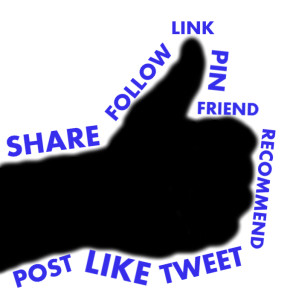10 Tips for B2B Cold Calling
Contact us to learn how we can help you lead a successful B2B cold calling campaign.
Contact us to learn how we can help you lead a successful B2B cold calling campaign.
 This is part 2 of a blog series on ways to be more effective with B2B social media marketing. Click here for part one.
This is part 2 of a blog series on ways to be more effective with B2B social media marketing. Click here for part one.
2. Pay attention to your metadata
When most people think of content metadata, they are thinking about SEO. However, metadata can also be a big part of what drives engagement on social media. Many companies today post blog content without specifying an ‘exerpt’ or ‘meta description’ to be displayed on social media sharing sites. These small details, like the title of the article and the quick blurb that describes what its about, can really make a huge difference when it comes to engagement.
To learn more about sharing best practices and how to optimize your content to generate sharing, check out these tips from Facebook.
3. Use visual information like infographics and video
If your in B2B marketing currently, you’ve likely been a witness to the amazing rise on popularity of visual content over the last few years. The huge amount of visual marketing content like infographics, videos, webcasts, Slideshare presentations, etc. out there today shows that companies are finding success with this approach. A recent blog from Atomic Research suggests that one reason for this may be that “Your brain processes images faster than text and attaching a graphic to your content can create a mental foothold for your audience, which will result in reads, clicks and leads.”
This means that anything you can do to make your content more visual will likely make it more engaging for your audience on social media. For more tips on creating visual content, you can check out Atomic Research’s article here. For more on video in B2B, you can read last week’s blog that discusses recent barriers to success.
For more tips on B2B social media marketing, you can read 3 Ways to Use Twitter More Effectively for B2B Marketing.
 In March, a story came out that found that stated the average American adult now spends 11 hours with digital media a day. While some of that time may be spent doing tasks like sending emails or surfing news sites, a 2014 marketing survey found that “than one in four minutes spent (28%) using smartphones is using social networking apps.”
In March, a story came out that found that stated the average American adult now spends 11 hours with digital media a day. While some of that time may be spent doing tasks like sending emails or surfing news sites, a 2014 marketing survey found that “than one in four minutes spent (28%) using smartphones is using social networking apps.”
Because consumers now spend more time than ever before interacting with digital devices and engaging in all types of digital content, it is no surprise that the social media marketing industry is still growing at a near exponential rate. With so many businesses now competing for their customer’s attention via digital devices and social media, it can be hard for smaller B2B companies to break through the noise and generate real value from social media marketing.
To help you be more effective with your B2B social media marketing efforts, here are three things that we see to be working right now:
Most people have heard this by now, but in case you haven’t, it is worth repeating. Google’s social platform, Google+, is now arguably one of the most important social media platforms for business. This is in part because of the close relationship between +1’s (Google+’s version of ‘likes’) and high rankings on Google’s regular SERPs. Essentially, the more +1’s and shares a piece of content gets on Google+, the higher it will rank in Google overall.
For more tips on using Google+ in B2B, you can check out this infographic that has great step-by-step instructions for getting started and offers advice on what types of content to share, how to find influencers and more.
Continue reading the second half of this blog.
This blog article is a short overview of B2B small business marketing in the digital era.
 As a small business, you don’t have anywhere near the amount of resources to develop a marketing strategy as your large business and Fortune 500 competitors.
As a small business, you don’t have anywhere near the amount of resources to develop a marketing strategy as your large business and Fortune 500 competitors.
That being said, the democratic nature of the internet means that even the smallest businesses have the chance to compete and grow. In other words, a viral marketing video is just as likely to come from a five-person start-up as it is an enterprise, if that startup has taken the time to understand their customers and produce content that speaks directly to their needs.
There are many ways you can go about small business marketing, and they pretty much all involve the internet. Here are several basic marketing tactics that any small business can leverage to find and connect with more customers:
Search Engine Optimization
You’ve probably heard talk about “how to improve your SEO,” which simply means getting higher on Google results pages. Google and other search engines have specific formulas for determining what pages rank the highest for each keyword. They take into consideration factors like keyword density, urls, meta descriptions and more when ranking pages for specific search terms. In order to show up higher on results pages, you need to “optimize” every page of your website to make it easy for Google to know what each page is about.
Understanding the rules of SEO is somewhat complex, but not impossible. Simply changing the urls for all of your blog posts might get you from page three to page one.
Social Media Marketing
For many small businesses, social media has been the best thing since sliced bread. That’s because pretty much all of your customers are already on social media, waiting for you to connect with them. Using social media networking sites sites like Facebook, Twitter, LinkedIn and Google+, you can create profiles and push marketing messages within communities that are your ideal market. Social media marketing also helps to humanize your brand and allows your customers to get to know you better.
Blogging
Blogging can be considered both an SEO strategy and a social media strategy, depending on your goals. Starting and maintaining a company blog gives you much more space to optimize keywords for search engines. Each blog post you write can have a slightly different keyword variant, allowing you to reach a wider customer base. Blogs can also be considered social media, as your prospects and customers can “follow” or “subscribe” to your blog to receive updates every time you publish something new. You can also post links to your blog articles on your Facebook, Twitter and LinkedIn profiles. If your content is valuable enough to your readers, they may share your content with their friends or followers, which becomes free advertising for you.
For more on small business marketing for B2B, click here. If you have any questions, please feel free to contact us.
 At Gabriel Sales, a B2B sales and marketing outsourcing company, we have experience accelerating the sales of both Fortune 1000 companies and small businesses. While the overall goals and basic sales strategy for each type of company is similar, they differ considerably in the amount of leads generated.
At Gabriel Sales, a B2B sales and marketing outsourcing company, we have experience accelerating the sales of both Fortune 1000 companies and small businesses. While the overall goals and basic sales strategy for each type of company is similar, they differ considerably in the amount of leads generated.
What we have found is that for small business B2B sales, companies have absolutely no chance of competing against their larger competitors if they do not implement the attitude that every lead matters. We believe it is imperative for small businesses to adopt the philosophy that you need to “work every lead.” Doing this will allows to increase the number of leads you put into your sales pipeline.
Our industry experience has shown us it is a pretty safe bet that your Fortune 1000 competitor employs an entire team exclusively to qualify leads. For this reason, we believe leveraging sales and marketing outsourcing team for this purpose may be necessary to keep up with the competition.
We also suggest this team, sometimes called a demand generation team, should directly report to the small business owner or the head of sales. This group should use a marketing automation platform and should be held responsible for the sales qualified leads put into the pipe. This will help ensure you reach your company’s hard sales goals in terms of revenue and your communication about progress happens in an ordered way.
Enacting the principle that every lead matters will make sure your small business is:
Professional—a lead that does not convert to a sales qualified lead may still turn into a referral, which can put you at an advantage in today’s ultra-connected world.
Responsive—there is evidence to show that ‘whoever gets there first, wins’ still applies in B2B sales.
Efficient—This structure will ensure that your company gets the best ROI on your program dollars, when measured in pipe to spend, or a close to spend type metrics.
Learning—every lead that does not qualify is an opportunity to learn something. The demand generation team will collect copious amounts of feedback in this process, which can be useful for improving your strategy in the future.
We have found that it is up to the small business owner or sales leader to be the champion of working every lead and to create the proper environment for this success. If you would like to know more about using an outsourced demand generation team for your small business B2B sales operations, feel free to contact us for a free benchmark and 30-minute needs analysis.

Technology Will Accelerate Marketing’s Impact on Revenue
In Part 1, Increase B2B Sales Volume and Revenue and Part 2,What Does Your B2B Sales Approach and B2B Marketing Culture Need to Look Like?, we discussed the new situation in B2B sales and how the buying process has changed, how marketing is more important to your sales process than ever, and how you may need to alter your sales process and augment your team.
In part 3, we outlined the 11 core competencies required to build a successful b2b demand generation marketing program that puts your buyers and their buying cycle (as opposed to your sales cycle) at the center of your sales and marketing process.
Now, in part 4, we explain the five key ways that marketing automation and sales technology can quickly shift your culture and help your sales team be more effective. The five ways are:
Here’s a brief explanation of how each of these features will help your sales team:
Lead Capture
For example, Pardot Marketing Automation Software allows you to identify companies that are visiting your site without the need for any information to be collected on a form. There is a database of IPs that identify the company. The major value here is identifying potential prospects without waiting for contact info to be submitted, using 3rd party data providers like Inside View, LinkedIn, One Source and SalesForceData to more quickly identify the key contacts within the companies visiting your site. These 3rd party data providers also help you pull in additional missing data points about the company and key contacts.
Just as important is actually capturing leads with landing pages and forms. That is nothing new, but the ability to then implement strong lead management rules helps hand over qualified prospects automatically.
Lead Qualification
There are two main ways to qualify leads: using implicit behaviors and activities and explicit data and demographics.
Using implicit information and lead scoring, you can rank and score activities (email, web and social) variably by importance and then set up actions to pass the top scoring prospects over to a sales rep automatically.
Using explicit data and lead grading, you can qualify a prospect on who that person is, e.g. a CEO versus a workaholic just trying to learn something new by requesting your content. You can also change grades up and down based on industry, company size and other factors. Essentially, it’s grading prospects against an ideal customer profile that your sales and marketing team identifies.
Along with helping your sales team avoid talking to bad prospects, using these grades and scores provides you another way to dynamically pre-qualify and assign the best prospects to your sales rep.
Email Automation
Email automation for sales reps takes their knowledge about and performance with their leads to another level. Reps can now use email integration tools for Outlook, Gmail, Apple Mail, and Thunderbird to send personal emails through their marketing automation tool, This allows them to personally track opens and clicks with automatic notifications being sent back to the rep when these actions are taken.
Another powerful email automation component is personalized email marketing campaigns, where the marketing team can craft a message to the companies entire pool of prospects, yet dynamically assign the “From” and “Email” field of the lead’s assigned rep. This serves two main purposes: 1) the rep will get the credit for a pleased lead being sent valuable content (yet the rep didn’t have to do anything – marketing and software took care of the touch for them) and 2) all replies to the content will go directly back to the rep (plus, the rep can also be notified when their lead interacts with that message).
A bonus aspect to email automation is the sales rep can pass back “not-yet-qualified” leads to be nurtured by marketing and allow for further lead qualification. The sales rep can be notified again once the lead qualification status has been improved based on the lead’s content interaction activities and scoring rules.
Lead Intelligence
Sales reps will be able to track all online behaviors (email, website and social) and that data can be put directly into the CRM that the sales rep works from, e.g. Salesforce, instead of requiring the sales rep to learn the ins and outs of the marketing automation prospect tracking system (though they probably will want to once they see how much more effective they are). Activities like original lead source, specific page views, keyword searches, webinar attendance, etc., can all be tracked. This allows the sales rep to profile and frame the content for conversations, voicemails and follow-up emails based on those specific prospect activities.
Real-Time Lead Alerts
Real-time lead alerts allow sales reps faster response time when companies or leads are actively engaged in the sales education collateral. Sales reps can receive instant alerts or daily email summaries regarding these activities. They can receive instant alerts via email, text messaging, mobile apps, and desktop apps, whichever they prefer.
With these alerts and summaries Reps can:
All of these features, Lead Capture, Lead Qualification, Email Automation, Lead Intelligence and Real-Time Lead Alerts, save your reps time and make them more successful. An effective integration and use of marketing automation can synthesize marketing and sales objectives and improve the effectiveness better than ever.
If you are still a little skeptical that marketing automation and content marketing are going to be critical to your success we invite you to check out our blog Content Marketing is Now Required for Quality B2B Lead Generation that will give you a little background on the risk you are running and the cost of delay.
If you want to learn more about how Gabriel Sales can combine your product knowledge and thought leadership with our sales and marketing automation expertise to get you in the game faster, request a complimentary review. If you want to review more information, download the White Paper for Tactics you can implement now.
Additional Blogs in this Series:
Part 1 – Increasing Your B2B Sales Volume and Revenue – What’s Changed?
Part 2 – What Does Your B2B Sales and Marketing Culture Need to Look Like?
Part 3 – What Core Competencies do I Need From My Marketing and Lead Generation Team?
Part 4 – How Can Marketing Automation Improve My B2B Sales Performance?
Part 5 – Why is Content Marketing is Now Required for Quality B2B Lead Generation?